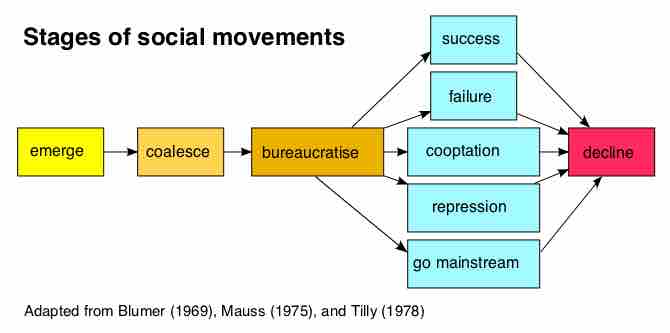Collective behavior refers to social processes and events that do not reflect existing social structure (laws, conventions, and institutions), as they emerge in a "spontaneous" way. Collective behavior might also be defined as action that is neither conforming (in which actors follow prevailing norms) nor deviant (in which actors violate those norms). Rather, collective behavior, a third form of action, takes place when norms are absent or unclear, or when they contradict each other. Scholars have devoted far less attention to collective behavior than they have to either conformity or deviance.
Examples of collective behavior include: religious revival meetings (like those depicted in the documentary Marjoe), a panic in a burning theater (e.g., the Kentucky Beverly Hills Supper Club fire), a sudden widespread interest in a website (e.g., MySpace) or clothing item (e.g., WristStrong bracelets), a collective social movement to improve the environment (e.g., Greenpeace), or the rapid spread of rumors (e.g., that Barack Obama is Muslim or not a US citizen). These diverse actions fall within the area sociologists call collective behavior.
Collective behavior differs from group behavior in three ways:
- Collective behavior involves limited and short-lived social interactions, while groups tend to remain together longer.
- Collective behavior has no clear social boundaries; anyone can be a member of the collective, while group membership is usually more discriminating.
- Collective behavior generates weak and unconventional norms, while groups tend to have stronger and more conventional norms.
Traditionally in sociology, collective behavior is displayed by four types of groupings of people: the crowd, the public, the mass, and the social movement . While there is debate over what should be included under the label of "collective behavior" among sociologists today, often included are additional behaviors like: rumors, riots, and fads.

Types of Social Movements
The four types of social movements, as described by cultural anthropologist David Aberle
Collective Behavior and Social Change
Collective behavior can actually change elements of society. This is the component of collective behavior known as "social movements. "
On March 7, 1965, African American leaders led a march of 600 people in an attempt to walk the 54 miles (87 km) from Selma to the state capital in Montgomery. Only six blocks into the march, however, state troopers and local law enforcement attacked the peaceful demonstrators with billy clubs, tear gas, rubber tubes wrapped in barbed wire, and bull whips. They drove the marchers back to Selma. The national broadcast showing footage of lawmen attacking unresisting marchers seeking the right to vote provoked a national response. Eight days after the first march, Lyndon Johnson delivered a televised address to garner support for the voting rights bill he had sent to Congress. In it he stated:
But even if we pass this bill, the battle will not be over. What happened in Selma is part of a far larger movement which reaches into every section and state of America. It is the effort of American Negroes to secure for themselves the full blessings of American life. Their cause must be our cause too. Because it is not just Negroes, but really it is all of us, who must overcome the crippling legacy of bigotry and injustice. And we shall overcome.
Johnson signed the Voting Rights Act of 1965 on August 6. The 1965 Act suspended poll taxes, literacy tests, and other subjective voter tests. It authorized Federal supervision of voter registration in states and individual voting districts where such tests were being used. The act had an immediate and positive impact for African Americans. Within months of its passage, 250,000 new black voters had been registered. Within four years, voter registration in the South had more than doubled.
Understanding how to organize a social movement to pursue social change is one of the areas studied by sociologists. The insights gained from these studies can provide movement members the tools they need to succeed .

Stages of Social Movements
The different stages of social movements, as adapted from Blumer (1969), Mauss (1975) and Tilly (1978)
Riots
A riot is a form of civil disorder characterized by disorganized groups lashing out in a sudden and intense rash of violence, vandalism, or other crime. While individuals may attempt to lead or control a riot, riots are typically chaotic and exhibit herd-like behavior. Riots often occur in reaction to a perceived grievance or out of dissent. Historically, riots have occurred due to poor working or living conditions, government oppression, taxation or conscription, conflicts between races or religions, the outcome of a sporting event, or frustration with legal channels through which to air grievances. Riots typically involve vandalism and the destruction of private and public property. Riots, while destructive, have often played a role in social change.